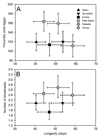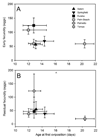Geographic Variation of Photoperiodic Diapause but Not Adult Survival or Reproduction of the Invasive Mosquito Aedes albopictus (Diptera: Culicidae) in North America
- PMID: 22707762
- PMCID: PMC3371371
- DOI: 10.1603/AN11032
Geographic Variation of Photoperiodic Diapause but Not Adult Survival or Reproduction of the Invasive Mosquito Aedes albopictus (Diptera: Culicidae) in North America
Abstract
Climate differences across latitude can result in seasonal constraints and selection on life-history characters. Because Aedes albopictus (Skuse) invaded North America in the mid-1980s, it has spread across a range of ≈14° latitude and populations in the north experience complete adult mortality because of cold winter temperatures that are absent in the south. Life-table experiments were conducted to test for differences in the adult survival and reproductive schedules of Ae. albopictus females from three populations from the northern (Salem, NJ; Springfield, IL; Eureka, MO; ≈39° N) and southern (Palm Beach, Palmetto, Tampa, FL; ≈27-28° N) extremes of the species distribution in North America. There were consistent differences between northern and southern populations in incidence of photoperiodically-induced egg diapause. Under short daylength, diapause eggs constituted twice the proportion of total viable eggs from northern females (81.9-92.1%) than southern females (35.9-42.7%). There were no consistent differences between northern and southern populations in resource allocation between reproduction and maintenance, reproduction over time, and reproductive investment among offspring, and no apparent trade-offs between diapause incidence with reproduction or longevity. Our results suggest that the main response of North American Ae. albopictus to unfavorable winter climates is via the life history strategy of producing diapausing eggs, rather than quantitative variation in reproduction, and that there are no detectable costs to adult survival. Inherent geographic variation in the expression of diapause, consistent with the latitudinal extremes of A. albopictus, indicates evolutionary loss of diapause response in southern populations because of the invasion of A. albopictus in North America.
Figures



References
-
- Armbruster P, Conn JE. Geographic variation of larval growth in North American Aedes albopictus (Diptera: Culicidae) Ann. Entomol. Soc. Am. 2006;99:1234–1243.
-
- Armbruster P, Hutchinson RA. Pupal mass and wing length as indicators of fecundity in Aedes albopictus and Aedes geniculatus (Diptera: Culicidae) J. Med. Entomol. 2002;39:699–704. - PubMed
-
- Bell G. The costs of reproduction and their consequences. Am. Nat. 1980;116:45–76.
-
- Birungi J, Munstermann LE. Genetic structure of Aedes albopictus (Diptera: Culicidae) populations based on mitochondrial ND5 sequences: evidence for an independent invasion into Brazil and United States. Ann. Entomol. Soc. Am. 2002;95:125–132.
-
- Blackmore MS, Lord CC. The relationship between size and fecundity in Aedes albopictus. J. Vector Ecol. 2000;35:212–217. - PubMed
Grants and funding
LinkOut - more resources
Full Text Sources
